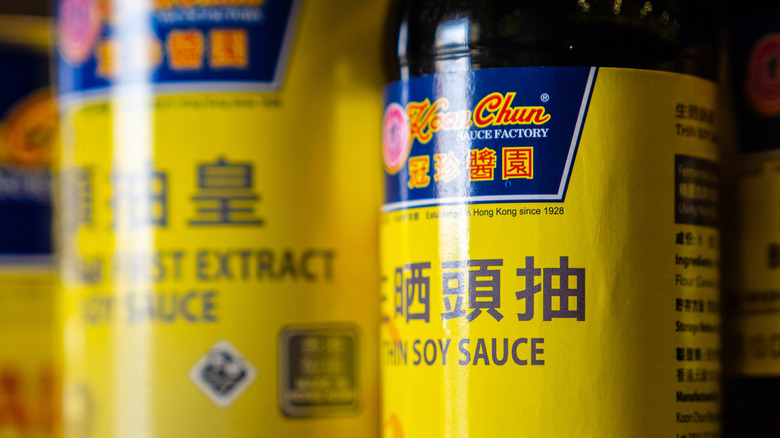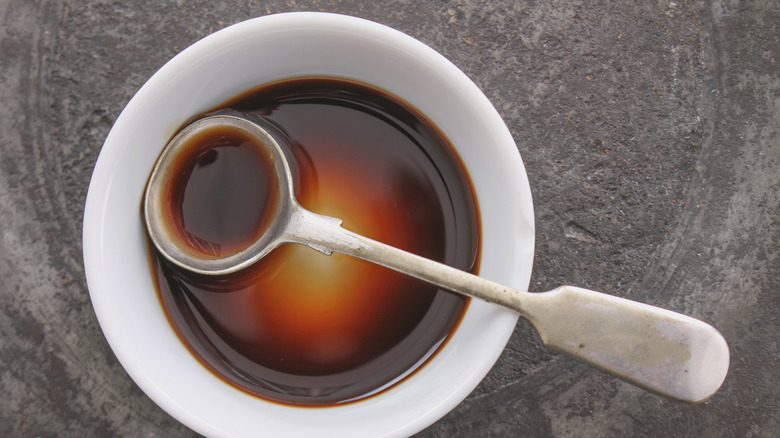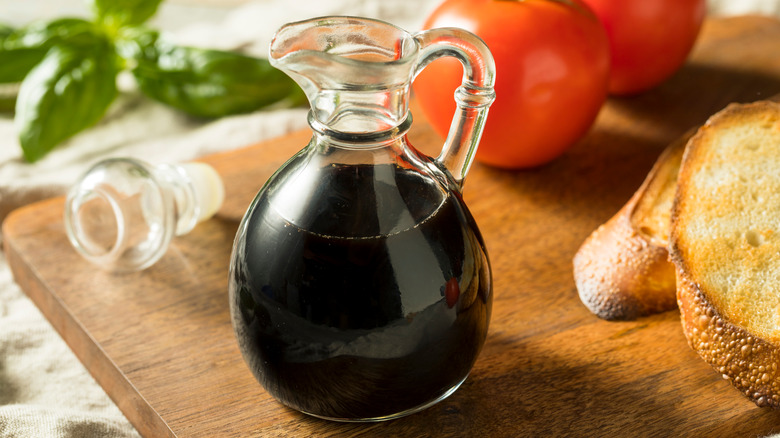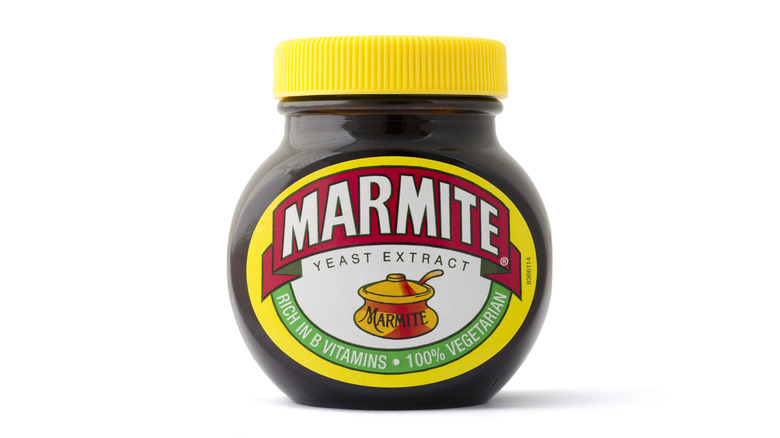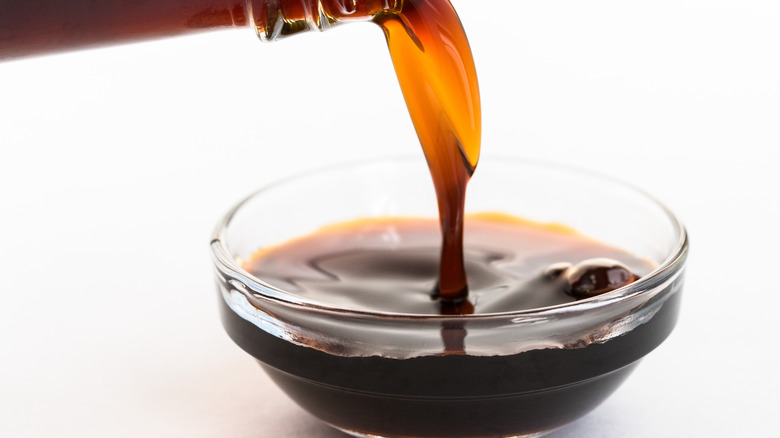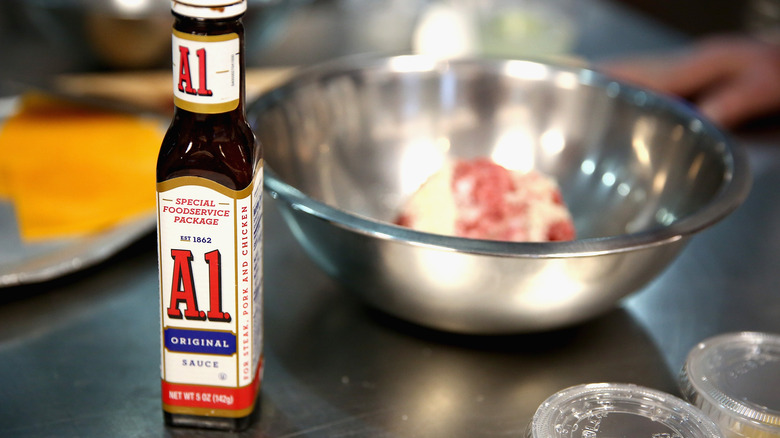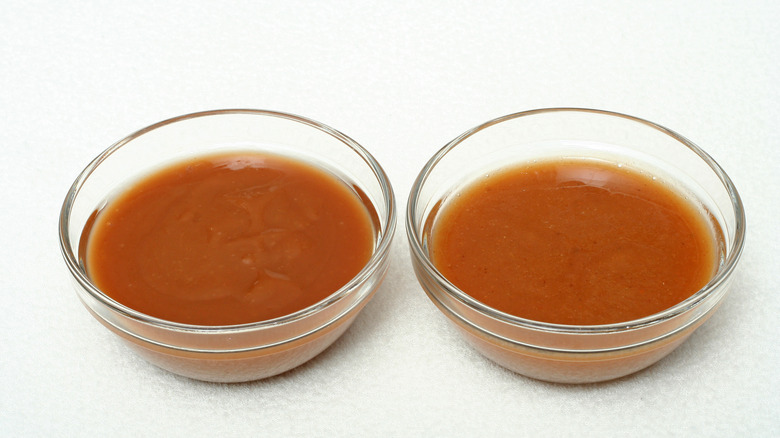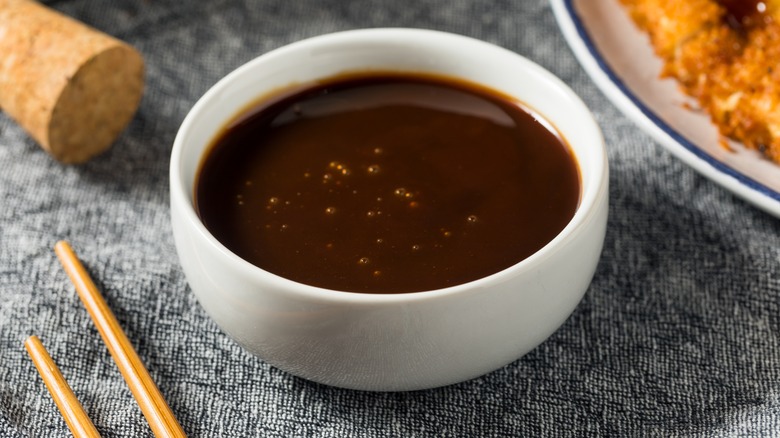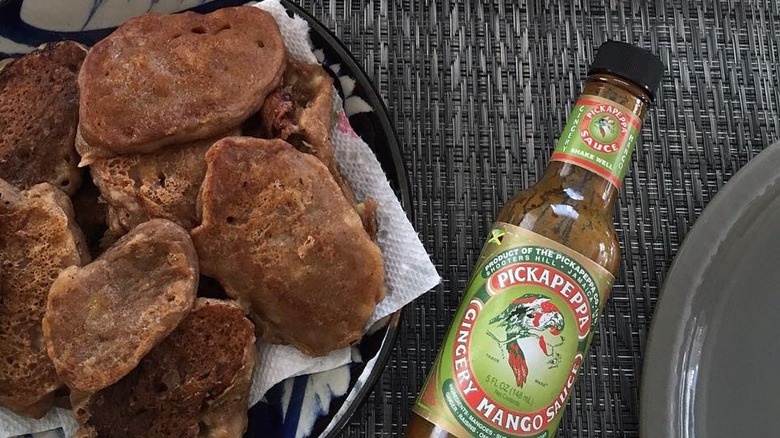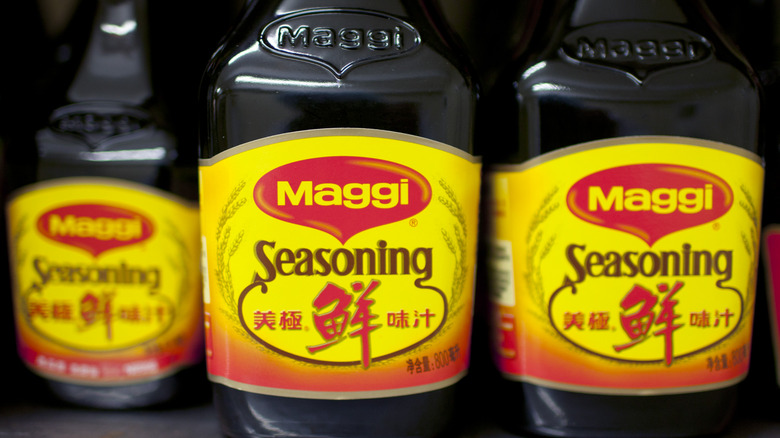The 11 Absolute Best Worcestershire Sauce Substitutes
The unsung hero of the back of the fridge. There's a reason this often-forgotten underdog is chef Alex Guarnaschelli's go-to ingredient for savory dishes, and what Jamie Oliver uses to kick his brussels sprouts up a notch.
Worcestershire sauce is a fermented condiment made from a combination of ingredients, including vinegar, molasses, sugar, anchovies, cloves, onion, garlic, and chili pepper extract. It may have been developed during the 18th century (in the sauce's namesake city of Worcester, England), but it remains a staple in the contemporary kitchen. Worcestershire is the secret weapon you never know you need — until you don't have it.
Next time you're making shepherd's pie for a table of hungry bellies, or a pot of meatballs for a crowded tailgate, Worcestershire sauce will be there, waiting for you to remember its uniquely tangy, umami flavor, and reach for it — unless you've run out. If you find yourself without the star ingredient of that savory dish or simply want to switch up the flavor profile a bit, here are the absolute best Worcestershire substitutes.
Soy sauce
Soy sauce isn't just for teriyaki chicken and dumplings. Statistically, you're likely to already have a bottle of soy sauce on hand since Americans use a lot of the stuff. Roughly 2.2 million Americans went through at least four bottles of soy sauce in 2020, per Statista.
Soy sauce is a combination of soybeans, wheat, water, and salt. Although they don't share many common ingredients, soy sauce can be a surprisingly fitting substitute for Worcestershire. Soy sauce and Worcestershire both have a unique, rich flavor, a dark color, and a heavily fermented taste. To use soy sauce as a substitute, it recommends simmering freshly grated ginger in ¼ cup of water and incorporating it into the soy sauce. The added ginger flavor will mirror Worcestershire's tangy, umami-heavy flavor profile. Molasses, it says, will also do the trick, if ginger isn't your thing.
Fish sauce
Fish sauce might be the unofficial champion of umami flavor. Umami, a term that was coined in 1908 by Tokyo University chemist Kikunae Ikeda, has been lauded as the "fifth taste," via The Guardian.
Fish sauce's distinct briny smell and salty, fermented taste make it a popular ingredient in Thai and Vietnamese dishes. Fish sauce is made from a combination of fish and salt, which is fermented for up to 12 months. Then, a concentrated liquid containing the fish extract is drained from the fermentation tanks, and this liquid is bottled as fish sauce.
Fish sauce and Worcestershire are linked by the prominent umami in their flavor profiles. Since both sauces are fermented and feature anchovies as a main ingredient, they boast the same strong, fishy taste. When substituting, it recommends using an equal ratio of Worcestershire to fish sauce. To further mimic Worcestershire's signature taste, try mixing your fish sauce with lemon or lime juice to make a condiment called "nam prik pla," which has a similar flavor dimensionality as Worcestershire.
Balsamic vinegar
There are countless different types of vinegar in the culinary world, but of these, balsamic vinegar is one of the most versatile. Balsamic vinegar is made from unfermented grape juice, which is responsible for its opaque dark color and sweet, acidic taste. Since vinegar is Worcestershire's main ingredient, using balsamic as a substitute keeps the sauce's tart sweetness from getting lost in translation.
To substitute, it's best to combine equal parts balsamic vinegar and tamarind paste. Tamarind is a fruit pod collected from trees native to Northern Africa and Asia (more on that later). The tamarind pods contain a sticky pulp, which is extracted and typically made into tamarind sauce, paste, juices, and concentrates. Combined with balsamic vinegar's acidic sweetness, the earthy flavor and thick viscosity of the tamarind make for an apt Worcestershire substitute.
Marmite
If you're looking for a flavor that evokes the salty, earthy, slightly funky notes of Worcestershire sauce, consider another salty, funky condiment with British roots: Marmite. This thick, dark brown, intensely flavored spread — beloved in its native Britain, but a bit polarizing elsewhere — is made from concentrated brewers' yeast extract and salt — lots of salt. This is why even its most ardent fans, many of whom even pack it with them when traveling overseas, will only spread it on their toast in the thinnest of layers.
And while thick, gooey Marmite seems at first glance to be an unlikely substitute for a thin sauce such as Worcestershire, there are a number of good reasons it can work as a substitute, at least in some cases. For once, the color is nearly identical, if that's a concern for the dish you're flavoring. And like Worcestershire sauce, Marmite is deeply salty and a bit funky. It also has sweet undertones, though not as distinct as those of Worcestershire. When adding Marmite to your dish, do so sparingly — a little goes a long way.
Coconut aminos
Worcestershire sauce is quite distinctive and has a complex range of flavors, so any substitute will likely capture only some of these. But for some recipes, especially those in which the sauce is used to add just a bit of extra depth and umami, you won't need your substitute to be an exact replica – just something close enough to evoke those flavor notes. Another good substitute for just this purpose may sound like an unlikely one: coconut aminos.
Don't worry — while coconut aminos are indeed made from coconut, it does not taste like coconut. Instead, it's a savory, thin, dark brown condiment made from fermented coconut palm sap and salt. Coconut aminos bear a strong resemblance to soy sauce, which itself is a good pinch-hitter for Worcestershire sauce in some dishes. Like soy sauce, it's salty with a bit of umami earthiness, but with a sweeter flavor. It also has a mild tanginess, echoing that of Worcestershire sauce, so can be used as a direct, one-to-one substitute for it. It's also naturally gluten-free, making it a good choice for cooks and diners avoiding Worcestershire sauce because of gluten intolerances.
A1/HP sauce
In some cases, cooks and eaters reach for a bottle of Worcestershire sauce for its sweet/tangy bite — its vibrant, fruity notes make a great foil for rich, meaty or cheesy dishes, as well as a nice flavor accent for a Bloody Mary. This is also why it's a favorite ingredient in marinades. So if it's the tangy, fruity character of Worcestershire that matters in your recipe, the best substitute will be something similarly puckery.
A great option in this case is another common condiment that you likely already have in your pantry: a steak sauce such as A1 or HP sauce. Made with tomato, orange, and raisin paste along with vinegar and flavorings including garlic and onions, it has a lot of the same fruity, sweet, and tangy notes as Worcestershire, and to many diners, tastes quite similar. It's a bit thicker, but has a similar puckery intensity and color and can be used similarly.
Oyster sauce
A secret ingredient that gives Worcestershire sauce much of its depth is one that everyone loves to hate: anchovies. While they don't make the sauce noticeably fishy, they do add a faint gamy, umami note that makes the sauce taste richer and deeper. And while anchovy-free (and thus, vegetarian-friendly) versions of Worcestershire can be found, for some tasters, that extra bit of depth anchovies contribute is what matters.
For those looking for a Worcestershire substitute that captures these notes, try another seafood-powered condiment: Chinese oyster sauce. Rumored to have been invented by accident by a cook who inadvertently left a pot of oyster soup on a burner overnight, it's a thick, dark-brown, salty-sweet sauce made from oysters, sugar, salt, flour, cornstarch, and flavorings, all cooked down until caramelized. Surprisingly, though, it doesn't taste anything like oysters. But it offers an intense hit of meatiness and umami, much like the note anchovies contribute to Worcestershire — and can be used in a pinch as a substitute.
Tamarind concentrate
When you're out of Worcestershire, a good strategy is to turn to the primary ingredients in Worcestershire as substitutes. For instance, since anchovies contribute much of the sauce's salty, meaty character, fish sauce — a condiment featuring anchovies or similar fish — can be a workable replacement. But if you're looking for a substitute that replicates the fruity, sweet-sour vibe of Worcestershire, turn to the ingredient that actually contributes it: tamarind, or more practically, tamarind concentrate.
Tamarind — the dark-brown pulp from the pods of the tamarind tree — doesn't get a lot of attention from American cooks, but it's a workhorse of the South Asian kitchen, where it lends its sharp, fruity flavor to sauces, pickles, and more. The taste will be familiar to you if you're fond of Worcestershire sauce. You can generally find tamarind in the U.S. as blocks of dried pulp from the pods (it has to be rehydrated before use) or as jarred concentrate – while tamarind aficionados find the latter less flavorful than the pulp, it's much more convenient.
Tonkatsu sauce
Because Worcestershire sauce packs such a big punch, we tend to use it sparingly, which means a bottle of it seems to last forever. And this is why we always get caught flat-footed when we suddenly find that bottle empty — is this actually supposed to happen? The good news is you may not, in fact, be totally out of Worcestershire sauce after all – at least not if you're a fan of Japanese condiments. If you have a bottle of tonkatsu sauce around, you have a direct culinary descendent of Worcestershire that bears a strong resemblance to its parent.
Tonkatsu are deep-fried, breaded cutlets of meat or chicken and were introduced into Japan from Europe in the 19th century, as was Worcestershire sauce, which quickly became a popular accompaniment to the new dish. Japanese cooks soon devised their own local version of the iconic sauce, which they simply called tonkatsu sauce. It has the same umami, tangy, fruity vibe as Worcestershire, but is thicker and sweeter. And it's close enough to Worcestershire sauce that recipes for homemade tonkatsu sauce call for Worcestershire (along with ketchup and oyster sauce) as a primary ingredient.
Pikkapeppa sauce
Cooks in the American South have long turned to Pikkapeppa sauce — a fermented, bottled Jamaican condiment made from tomatoes, raisins, vinegar, mangoes, and spices — as a fruitier, spicier substitute for Worcestershire sauce. Indeed, its flavor is strikingly similar to that of Worcestershire. And like tonkatsu sauce, its ingredients are basically a superset of those in Worcestershire — but in this case, with the addition of tropical accents such as mango. It's also slightly thicker and sweeter than Worcestershire, differences that have made it suitable for another popular use of the sauce: pouring it over a block of cream cheese as a quick party appetizer.
But while Pikkapeppa bears an unmistakable resemblance to Worcestershire sauce, it appears to have developed independently – it was said to have been invented by a Jamaican teenager experimenting in his family's kitchen in 1921. Today, the exact recipe is a proprietary secret. But whether or not its young inventor was inspired by Worcestershire sauce, the popularity of Pikkapeppa is another example of how a compelling flavor profile can be embraced by eaters around the world.
Maggi seasoning
Maggi seasoning is one of those ingredients that's either indispensable or invisible, depending on whom you ask. If it's not already in your kitchen, chances are you've barely noticed it in the bottled sauce aisle. But for some cooks, the thin, dark brown liquid, made primarily from fermented wheat, is a must-have: Its complexly rich, savory flavor, which some describe as akin to soy sauce but smokier with roasty notes, seems to enhance the flavor of everything it touches, from stews to seafood to cocktails.
While Maggi's many loyal fans may be hard-pressed to describe its exact flavor, some have noted that it bears a resemblance to Worcestershire sauce, albeit without the tangy sweetness. This can make it an effective pinch-hitter if you need a Worcestershire substitute to add depth to a sauce but aren't interested in adding a lot of extra sweetness. It's worth noting, however, that depending on where you get your Maggi, the exact flavor it contributes will vary. While originally invented in Switzerland, it has been embraced by cooks around the world, and the Maggi sold in each region has been tailored to local tastes. For instance, the original Swiss-German version is enhanced with vegetable flavorings, while Filipino Maggi features garlic accents and Mexican Maggi is sharper and more intense.

